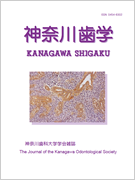- HOME
- > 一般の方
- > バックナンバー:神奈川歯学
- > 27巻3号
- > アブストラクト
アブストラクト(27巻3号:神奈川歯学)

Japanese
| Title : | ヒト歯根膜線維芽細胞の細胞接着・伸展因子 - 細胞成長因子による調節 - |
|---|---|
| Subtitle : | 原著 |
| Authors : | 加藤喜夫, 川瀬俊夫, 斎藤滋 |
| Authors(kana) : | |
| Organization : | 神奈川歯科大学口腔生化学教室 |
| Journal : | 神奈川歯学 |
| Volume : | 27 |
| Number : | 3 |
| Page : | 293-310 |
| Year/Month : | 1992 / 12 |
| Article : | 原著 |
| Publisher : | 神奈川歯科大学学会 |
| Abstract : | 「緒言」歯周疾患の治癒過程の主要な目標は失われたセメント質, 歯槽骨さらに非石灰化の結合組織である歯肉あるいは歯根膜の再生であり, セメント質表層への細胞の再付着である. Melcher AHおよび川瀬らは歯周組織の再生において, 疾患治癒部位に細胞が遊走し, 細胞の接着が起こり, その後細胞の増殖と分化の過程を通じて, 細胞外基質成分の合成が調節され, 歯槽骨とセメント質で石灰化することになると論じている. Buser Dらは, セメント質は歯根膜なしでは形成されないばかりか, 歯根膜自身の再生において歯根膜組織は必須要因であることをサルを用いてチタンの人工歯根の研究から明らかとなったと報告している. しかも, 歯根膜は発生学的に歯槽骨とセメント質と同様に歯小襄由来であり, 歯根膜の線維芽細胞のprogenitor cellsばかりでなく, 石灰化組織である歯槽骨とセメント質中の骨芽細胞とセメント芽細胞へ分化するprogenitor cellsが存在するとの報告もある. |
| Practice : | 歯科学 |
| Keywords : | HPLF, CASF活性, 細胞成長因子 |
English
| Title : | Cell Attachment and Spreading Factors of Human Periodontal Ligament Fibroblasts - Regulation by Cell Growth Factors - |
|---|---|
| Subtitle : | |
| Authors : | Yoshio KATO, Toshio KAWASE, Shigeru Saito |
| Authors(kana) : | |
| Organization : | Department of Oral Biochemistry, Kanagawa Dental College |
| Journal : | Kanagawa Shigaku |
| Volume : | 27 |
| Number : | 3 |
| Page : | 293-310 |
| Year/Month : | 1992 / 12 |
| Article : | Original article |
| Publisher : | Kanagawa Odontological Society |
| Abstract : | Abstract : Recently, considerable attention has been directed toward extracellular and cell growth factors to understand the processes of periodontal disease as well as the function of the cells of periodontium. Cell attachment and spreading factors(CASFs)might be important in the regenerative mechanisms which direct the behavior of cells, such as cell attachment, proliferation and differentiation. Previous research has been conducted to study the factors in the conditioned medium(HPLF-CM)of confluent HPLF modulated the migration, proliferation, ALPase expression and cell attachment-spreading of HPLF. The purpose of this study was to evaluate the regulation of CASF activity of HPLF-CM derived from confluent HPLF incubated with FCS and other growth regulatory factors. The HPLF-CM cultured with or without FCS was assayed the CASF activity by microscopic observation and the DNA content of cells. The intact 1% FCS HPLF-CM decreased the CASF activity compared with the FCS-free HPLF-CM. But when the 1% FCS HPLF-CM was diluted eight-fold to sixteen-fold, the CASF activity of diluted 1% FCS HPLF-CM dramatically increased like that of FCS-free HPLF-CM. Furthermore, the confluent HPLF exposed with cytokines, PDGF-AB, EGF, TGF-β1 or IL-1β was analyzed for CASF activity. PDGF-AB and EGF inhibited the CASF activity of HPLF-CM at approximately 21% and 38% compared with FCS-free HPLF-CM, respectively. In order to separate the molecules which inhibited the CASF activity of HPLF-CM, the 1% FCS HPLF-CM was applied to IEC-DEAE column eluted with PBS(-) containing 0.1mM phenylmethyl sulfonyl fluoride. The separated fractions were mixed with the whole FCS-free HPLF-CM and assayed the CASF activity. 0.39M NaCl eluted fraction inhibited the CASF activity of whole FCS-free HPLF-CM. Therefore, the HPLF which was fully differentiated could maintain the secretion of CASFs in the culture medium. When HPLF was exposed with growth factors which modulate the cell proliferation, HPLF can produce the inhibitor of CASFs. Thus, these findings provide the basis for further studies on the mechanisms of regeneration and reattacchment of periodontium. |
| Practice : | Dentistry |
| Keywords : |
